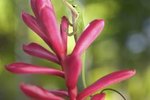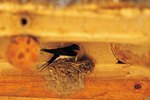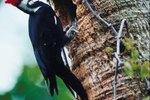
There are bluebirds and there are blue birds, and no matter which type of blue feathered friend you're looking for, you'll likely spot one in Tennessee. The eastern bluebird is common throughout the state. Blue birds that call the volunteer state home include blue jays, blue grosbeaks and belted kingfishers.
Eastern Bluebird
This fellow is a medium-sized songbird, running about 7 inches long. He's fairly easy to spot because of his bright blue back, wings and tail and reddish-brown breast. The eastern bluebird sings a pleasant song and prefers areas without ground cover, such as orchards or parks. If you have a large lawn, you'll likely see him helping out with insect control, as he feeds on insects, including spiders and worms. He relies on fruits and seeds during the winter and will appreciate raisins or currants if you leave them out for him.
Year Round Residents
In addition to the eastern bluebird, a couple of blue birds live in Tennessee throughout the year. The noisy blue jay is distinctive with his bright blue feathers and unmistakable head crest. He's a big fellow, running about 11 inches long. Home can be farmlands or forests, or even your backyard. He's an opportunistic feeder, dining on nuts, seeds and fruits, as well as animal proteins such as insects, frogs and mice. He'll occasionally sneak into bird nests and steal eggs and baby birds. The jay will happily relieve your feeder of cracked corn, sunflower seed and suet. If you live near a river or lake, keep an eye open for the belted kingfisher. This large guy -- who can be more than a foot long -- prefers to eat fish, swallowing them whole. If fish aren't around, he'll eat mollusks and crustaceans, reptiles, amphibians, insects, berries and young birds. He has a blue-gray color on his top and sports a spiky, bushy crest.
Summer Residents
Some blue birds enjoy summering in Tennessee, arriving in the spring and departing late summer into early autumn. During the warm months, keep an eye open for the cerulean warbler, a small bird about 5 inches long with a pretty blue back and head. He's white underneath and sports white bars on his wings. He forages in trees for caterpillars and also enjoys eating insects, and may accept an offering of fruit and nuts. The blue grosbeak is larger -- around 7 inches long -- and shows off a bright blue body. His wings are brown and black. Insects and seeds are the mainstays of his diet, but he'll partake of millet, safflower, apple slices and other fruits from generous people. You may lure the indigo bunting with the same offerings. He's an eye-catching little blue bird, showing a brilliant blue on his back, belly and breast with black on his wings. Left on his own, he'll eat insects, buds, berries and seeds.
Keeping to the East
If you're in eastern Tennessee, you may come across the black-throated blue warbler, who's common in the state during the summer months. He's a bit more than 5 inches long and is a striking slate blue color with a dark blue throat and mask over his eyes. The female of the species -- a dull, olive green -- is so different in appearance that initially, she was considered a different species. Insects are the mainstay of his diet, however he'll also eat fruits and nuts.
References
- Tennessee's Watchable Wildlife: Blue Grosbeak
- Tennessee's Watchable Wildlife: Eastern Bluebuird
- Tennessee's Watchable Wildlife: Indigo Bunting
- WhatBird.com: Eastern Bluebird
- WhatBird.com: Belted Kingfisher
- WhatBird.com: Blue Jay
- Tennessee's Watchable Wildlife: Black-Throated Blue Warbler
- Tennessee's Watchable Wildlife: Cerulean Warbler
Resources
Photo Credits
-
Jupiterimages/Photos.com/Getty Images




